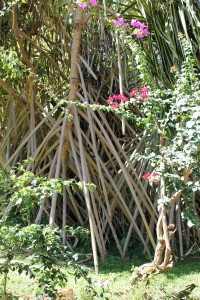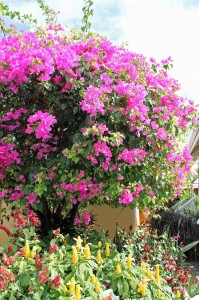The Land of No Groundhogs
January 31st, 2012
When you weren’t looking, my wife and I sneaked away on a 12-day cruise to St. Thomas, St. Kitts, St. Lucia, Antigua and St. Maarten.
It was magnificent, and it not only lopped nearly 2 weeks off winter, it gave me a look at plants and gardens of the Caribbean. Click here to see a slide show of pictures from the trip.
Here are my top 10 observations on how gardening in the Caribbean is different from gardening in central Pennsylvania:
1.) Caribbean gardeners don’t have to worry about deer, groundhogs and rabbits. However, goats might eat your pineapples on Antigua, and gardeners on St. Kitts gave up growing bananas because of the wild monkeys (two for every one person on the island).
2.) Pest bugs are surprisingly rare. No Japanese beetles, no emerald ash borers, and people don’t even have screens in their windows. One of the main worries is a moth the size of a bat that produces one heckuva leaf-eating caterpillar.
3.) Be careful when picking your mangos on St. Maarten. You might grab the tail of a very large tree-climbing iguana.
4.) Like our tomatoes, bananas are so much sweeter when picked fresh. Coconut water is still bland – fresh or packaged – and cocoa beans are much better after they’re processed into milk chocolate. The beans are slimy but sweet. St. Lucians suck on them raw and call them “jungle M&Ms.”
5.) They’ve got some crazy plants in the Caribbean. The traveler’s palm looks like a huge green mohawk haircut on a pole, and its fronds always line up east to west no matter how you plant it. The screw pine is a tree that puts out a few dozen angled trunks that look like legs, hence the nickname “walking tree.” And the pink torch lily is a beautiful allium-like pink bloomer that apparently doesn’t like people. It dies if you touch it. (No, I didn’t touch it to see… I took our guide’s word for it.)
6.) Everything seems to grow bigger and more colorful on the islands. It’s amazing what regular rain, abundant sunshine and a growing season that never ends can do. (For more on this, see my Patriot-News garden column coming up in the Feb. 2, 2012, edition.)
7.) The Caribbean really doesn’t have seasons as we know them. Temperatures stay in the 70s and 80s all year long, and day lengths vary little. Some islands (and parts of islands) are drier than others, but the rainforest of St. Lucia gets 160 inches a year – more than triple the amount we got in our record-setting monsoon year last year. Their “seasons” come in just two forms: dry and wet.
8.)The three Caribbean landscape plants I most wish we could grow are: bougainvillea (a bushy vine that’s covered in deep pink or lavender flowers); oleander (an upright shrub with narrow leaves and big pink flowers at the top), and clerodendrum (a small tree with spidery purple and white flower clusters).
9.) Caribbean gardens are filled with plants we think of as “houseplants.” Peace lilies and chenille plants are popular shade plants. Philodendrons, wandering jews and snake plants grow as groundcovers. Crotons grow as 6-foot-tall hedges, and cordylines, hibiscus and copper plants are popular sun shrubs.
10.) Maybe we can’t grow all of the lush, colorful, tropical stuff, but Caribbean islanders can’t grow many of the beauties we can. I saw no dogwoods, no hydrangeas, no maples, no rhododendrons and very few roses. Without seasons, there’s no dormant time that triggers such landscape action as spring bulbs, May-blooming shrubs and fall foliage. I don’t think I’ll move there, but 80 degrees in late January sure felt good.










